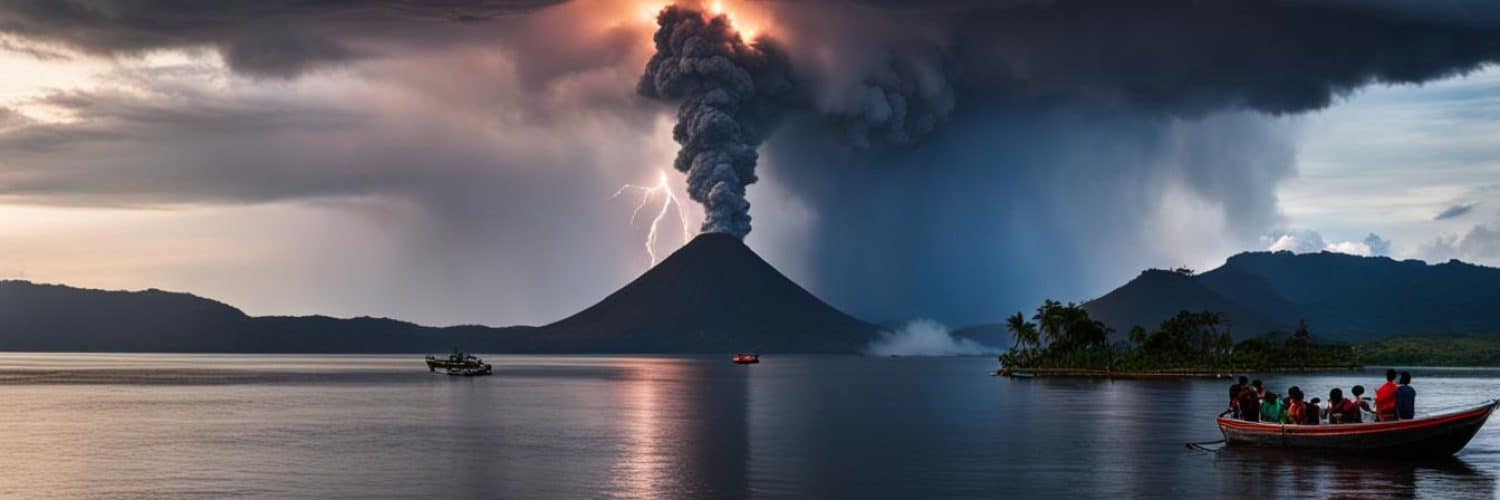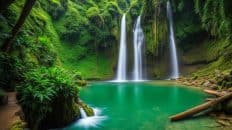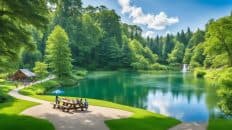Welcome to the enchanting world of Lake Taal and Taal Volcano in the Philippines. Nestled in the province of Batangas, these captivating natural wonders are a sight to behold. From the majestic Taal Volcano to the tranquil Taal Lake, this region offers a unique blend of beauty, history, and adventure.
Taal Volcano is one of the smallest yet most active volcanoes in the world. Situated in the center of Taal Lake, its towering presence is both awe-inspiring and intriguing. The area is rich in history, with a long list of historical eruptions that have shaped the landscape and left a lasting impact on the people and culture of the Philippines.
Exploring the wonders of Lake Taal and Taal Volcano allows you to witness firsthand the geological activity that has shaped this extraordinary land. From the lush forests and grasslands to the diverse array of flora and fauna, the Taal Lake ecosystem is a fascinating tapestry of life. It is here that nature reveals its raw beauty and resilience.
Key Takeaways:
- Lake Taal and Taal Volcano offer a unique blend of beauty, history, and adventure.
- Taal Volcano is one of the smallest yet most active volcanoes in the world.
- The region’s rich history and geological activity have shaped a captivating landscape.
- The Taal Lake ecosystem boasts diverse flora and fauna, making it a haven for nature enthusiasts.
- Exploring Lake Taal and Taal Volcano allows you to witness the wonders of nature up close and personal.
Geology and Formation of Taal Volcano and Lake Taal
Taal Volcano, situated on the island of Luzon in the Philippines, is a remarkable geological formation. This stratovolcano is composed of alternating layers of ash, lava, and volcanic rock, giving it its distinct appearance and character.
The stratovolcano of Taal is a testament to the dynamic forces of nature, revealing the earth’s power and strength.
But what sets Taal Volcano apart is its caldera, a large crater-like depression that formed when the volcano’s cone collapsed after a major eruption. This caldera later filled with water, giving birth to the serene Taal Lake, an expanse of beauty and tranquility.
The formation of Taal Volcano and Lake Taal can be attributed to the movements of tectonic plates beneath the surface. The Philippines is situated at the convergence of two major plates, the Philippine Sea Plate and the Eurasian Plate, resulting in intense geological activity.
Tectonic Plates in the Philippines and their Impact on Taal Volcano
| Tectonic Plates | Interactions | Impact |
|---|---|---|
| Philippine Sea Plate | Subducts beneath the Luzon island | Contributed to the formation of Taal Volcano |
| Eurasian Plate | Collides with the Philippine Sea Plate | Causes volcanic and seismic activity in the region |
The ongoing geological activity in the region has shaped the dramatic landscape of Taal Volcano and created the enchanting Taal Lake. It is a constant reminder of the delicate balance between the earth’s forces and the beauty that arises from it.
Witness the grandeur created by the convergence of tectonic plates – Taal Volcano and its magnificent lake.
Historical Eruptions and Geological Activity
Taal Volcano, known for its rich volcanic history, has experienced numerous eruptions throughout the years. These eruptions have shaped the landscape and left a significant impact on the surrounding areas. Let’s explore some of the most notable eruptions and the geological activity associated with Taal Volcano.
Notable Eruptions
Taal Volcano has recorded 33 eruptions dating back to 1572, making it a highly active volcano. Some of the most significant eruptions include:
- A VEI-4 eruption in 1911: This eruption caused widespread damage and resulted in pyroclastic flows and ashfall, affecting nearby communities.
- A VEI-2 eruption in 1965: This eruption lasted for several months, with periodic ash emissions and volcanic activity.
- A VEI-2 eruption in 1977: This eruption led to the formation of a new island within Taal Lake, showcasing the dynamic nature of the volcano.
These eruptions demonstrate the unpredictable nature of Taal Volcano and its potential to impact the surrounding environment.
Recent Unrest and Impact
In recent times, Taal Volcano has experienced episodes of unrest, raising concerns about the potential for future eruptions. In 2020, the volcano erupted with a VEI-2 eruption, resulting in ashfall and the evacuation of nearby communities. The eruption reminded everyone of the volcano’s active nature and the need to remain vigilant.
The volcanic activity of Taal Volcano has a significant impact on the surrounding areas. Not only do eruptions pose immediate dangers, such as pyroclastic flows and ashfall, but they also have long-term effects on the landscape and ecosystem. The continuous volcanic activity shapes the geological features of the region and influences the flora and fauna that thrive in the area.
“Volcanoes are nature’s way of reminding us that we are mere inhabitants on this planet, and it is our responsibility to respect and understand their power.”
– Unknown
Biodiversity and Ecosystem around Taal Lake
The ecosystem surrounding Taal Lake is a thriving hub of biodiversity, with a diverse array of flora and fauna calling this region their home. From the wetlands to the grasslands, forests, and rocky outcrops, Taal Lake supports a rich variety of endemic species that are found nowhere else on Earth.
The lush wetlands teem with life, providing a vital habitat for a myriad of plant and animal species. The grasslands, with their vast expanses of open space, create the perfect conditions for various organisms to flourish. The forests, with their towering trees and dense undergrowth, support a complex and intricate web of life. And the rocky outcrops, rugged and unforgiving, harbor unique plants and creatures adapted to these harsh conditions.
“The beauty and diversity of the flora and fauna in and around Taal Lake are truly awe-inspiring. It is a testament to the richness and resilience of nature.”
The remarkable biodiversity of Taal Lake extends beyond its endemic species. As an important stopover for migratory birds, the lake serves as a vital rest and refueling point for these winged travelers on their long journeys. These migratory birds further enhance the ecological significance and diversity of the region.
Beyond its inherent beauty and ecological importance, Taal Lake provides essential ecosystem services. Its wetlands play a crucial role in regulating water flow and filtering pollutants, helping to maintain water quality. The surrounding forests contribute to carbon sequestration, mitigating the impacts of climate change.
However, the biodiversity and ecosystem of Taal Lake face numerous threats. Habitat destruction, driven by human activities such as land conversion and urbanization, poses a significant risk. Pollution from various sources, including industrial waste and agricultural run-off, further degrades the ecosystem. These threats jeopardize the delicate balance and interconnectedness of Taal Lake’s flora, fauna, and ecosystems.
To safeguard the invaluable biodiversity and ecosystem services provided by Taal Lake, conservation efforts are imperative. This entails protecting and restoring habitats, implementing sustainable land-use practices, and raising awareness about the significance of preserving this unique natural treasure.
| Ecosystem | Key Highlights |
|---|---|
| Wetlands | Important habitat for aquatic plants and animals |
| Grasslands | Diverse plant and animal species adapted to open environments |
| Forests | Supports a complex web of life and contributes to carbon sequestration |
| Rocky Outcrops | Harbors unique species adapted to harsh conditions |
Threats to Taal Lake’s Biodiversity
- Habitat destruction through land conversion and urbanization
- Pollution from industrial waste and agricultural run-off
Conservation Efforts
- Protecting and restoring habitats
- Implementing sustainable land-use practices
- Raising awareness about the importance of biodiversity preservation
Cultural Significance and Folklore surrounding Taal Volcano
Taal Volcano and Lake Taal are not only natural wonders but also hold immense cultural significance in the Philippines. Revered and considered sacred by indigenous communities, this majestic volcano and its surrounding lake are deeply intertwined with local folklore, myths, and legends.
The rich cultural heritage associated with Taal Volcano and Lake Taal is a testament to the deep spiritual connections that indigenous communities have with the area. For generations, stories and oral traditions have been passed down, recounting the origins of the volcano and its mystical powers.
“Legend has it that Taal Volcano emerged from the sea thanks to a powerful deity who separated the land and the water, creating a haven for life. The volcano’s eruptions are believed to be a manifestation of the deity’s presence and influence,” explains Dr. Maria Santos, a folklore researcher at the University of the Philippines. “Indigenous communities perform rituals and ceremonies to honor the volcano and seek its protection.”
Furthermore, Taal Volcano and Lake Taal are pilgrimage sites where devotees from different parts of the country gather to pay their respects and seek blessings. The pilgrimage routes leading to the volcano are adorned with prayer flags and small shrines, adding to the spiritual ambience of the area. The pilgrimage experience is not just a religious practice but also an opportunity to connect with nature and reflect on one’s faith.
The cultural significance and spiritual ties have earned Taal Volcano and Lake Taal the recognition of being a UNESCO World Heritage Site. This prestigious status further highlights the remarkable value these natural wonders hold, not only in terms of geological significance but also in preserving the rich cultural heritage of the Philippines.
To fully appreciate the cultural significance and folklore surrounding Taal Volcano and Lake Taal, engaging with indigenous communities and local guides is highly recommended. They can share captivating stories, traditions, and rituals that have been passed down through generations, offering visitors a deeper understanding and appreciation of the area’s cultural heritage.
Indigenous Communities Associated with Taal Volcano
| Community | Cultural Significance | Associated Folklore |
|---|---|---|
| Taal | Considered the ancestral land of the Tagalog people | Legends of a mystical bird guarding the volcano |
| Lipa | Known for the annual Taal Basilica procession | Beliefs in the volcano’s healing properties |
| Talisay | Home to the Taal Lake Yacht Club and resorts | Myths surrounding the formation of Taal Lake |
Threats and Conservation Efforts for Taal Volcano and Lake Taal
Taal Volcano and Lake Taal, despite their natural beauty, are not immune to threats. The continued growth of urban areas and increased human activity in the region have led to habitat destruction and pollution, endangering the delicate balance of this unique ecosystem. Additionally, the introduction of non-native species poses a risk to the native flora and fauna.
To combat these threats, various conservation efforts have been implemented. One significant initiative is the establishment of the Taal Volcano Protected Landscape and Seascape. This protected area aims to safeguard the biodiversity and ecosystem of Taal Volcano and Lake Taal, ensuring their preservation for future generations. Through strict regulations and habitat management, the protected area contributes to the long-term sustainability of this natural wonder.
Conservation Initiatives:
- Reducing water pollution: Efforts are focused on minimizing the discharge of pollutants into the lake, preventing contamination of the water and the surrounding habitats.
- Implementing best management practices: Conservation organizations work closely with local communities and stakeholders to promote sustainable resource use and conservation practices, ensuring the preservation of the unique natural resources in the area.
By prioritizing conservation and implementing proactive measures, experts are working to mitigate the threats facing Taal Volcano and Lake Taal. These efforts not only preserve the diverse wildlife and plants but also protect the fragile balance of the ecosystem, promoting the long-term sustainability of this picturesque natural area.
| Threats | Conservation Efforts |
|---|---|
| Habitat Destruction | Establishment of the Taal Volcano Protected Landscape and Seascape |
| Pollution | Reduction of water pollution through strict regulations |
| Non-native Species | Implementation of best management practices and awareness campaigns |
Laoag: Gateway to Lake Taal
Laoag, located in the Philippines, serves as the ideal gateway to Lake Taal, offering visitors a wide array of unique experiences. As soon as you set foot in Laoag, you’ll be captivated by its stunning coastal desert landscapes. The picturesque region of La Paz boasts magnificent sand dunes, creating an adventurous playground for thrill-seekers.
Imagine the excitement of racing across the expansive sand dunes in an ATV or feeling the rush of sandboarding down the steep slopes. Laoag’s sand dunes deliver an adrenaline-pumping experience like no other, immersing you in the beauty of the coastal desert.
Are you ready to take your adventure to the next level? Laoag’s coastline offers the perfect opportunity for kite surfing enthusiasts looking to harness the power of the wind and ride the waves. With expert instructors guiding you every step of the way, you’ll quickly learn the skills needed to navigate the waters and perform exhilarating tricks. As you glide across the waves, you’ll be treated to breathtaking coastal views that will leave you in awe.
Why Choose Laoag for your Adventure?
- Experience the thrill of racing across epic sand dunes on ATVs.
- Master the art of sandboarding and conquer the steep slopes.
- Learn kite surfing with expert instructors along the breathtaking coastline.
- Enjoy panoramic coastal views from the comfort of a yacht.
Whether you’re an adrenaline junkie or simply seeking an unforgettable adventure, Laoag has it all. The combination of coastal desert landscapes, sand dunes, kite surfing, and expert instruction creates an experience that is both thrilling and awe-inspiring. So, pack your bags, and get ready to embark on an extraordinary journey in Laoag, the gateway to Lake Taal.
Banaue: Flying Over the Banaue Rice Terraces
Banaue is a destination renowned for its breathtaking Banaue Rice Terraces, often hailed as the eighth Wonder of the World. To truly appreciate the grandeur of these ancient rice paddies, visitors can embark on a once-in-a-lifetime experience – soaring above them in ultralight aircraft, offering a mesmerizing aerial view.
The Banaue Rice Terraces, crafted over two thousand years ago, stand as a testament to the extraordinary ancient engineering skills of the Ifugao people. These awe-inspiring terraces, carved into the mountainside, showcase the utmost harmony between nature and human ingenuity. Recognized as a UNESCO World Heritage site, they are a treasure that should not be missed.
After witnessing the splendor of the Banaue Rice Terraces from the air, the adventure continues with a wild lunch experience like no other. The skilled crew aboard the yacht will prepare a delectable feast amidst the rice paddies, immersing guests in the tranquil and picturesque surroundings. Indulging in a flavorful meal while being surrounded by the ancient wonders creates an unforgettable dining experience.
Prepare to be captivated as you soar above the majestic Banaue Rice Terraces and indulge in a wild lunch among the paddies. This extraordinary experience will not only give you a unique perspective on the ancient engineering marvels but also provide a chance to savor the beauty of nature and culture in one incredible journey.
Coron: Exploring Secret Islands and Sacred Cliffs
Coron is a breathtaking destination that captivates visitors with its stunning islands, pristine coastlines, and enchanting landscapes. The region boasts glittering lakes and jungle-covered karst formations that create a truly mesmerizing setting. One of the highlights of a visit to Coron is the opportunity to explore secret islands and witness the awe-inspiring limestone cliffs.
Pelorus, a leading travel company, can arrange special permissions for visitors to access private islands in Coron, providing an exclusive and immersive experience. This allows travelers to connect with the indigenous Tagbanua people, who have a deep cultural connection to the region.
One of the most exciting activities in Coron is witnessing the unique climbing skills of the Tagbanua people. These skilled climbers scale seemingly vertical limestone cliffs in search of edible birds’ nests. Visitors can join the Tagbanua as they climb the cliffs, guided by the locals, and learn about their cultural rituals and traditional crafts along the way.
Tagbanua Cultural Rituals and Crafts
The Tagbanua people have a rich cultural heritage and are known for their vibrant rituals and traditional crafts. During the guided climb, visitors will have the opportunity to learn about Tagbanua cultural practices and witness the craftsmanship firsthand. From intricate weaving to skilled woodcarving, the Tagbanua’s traditional crafts showcase their deep connection to their surroundings.
“The Tagbanua’s cultural rituals and crafts are an integral part of their identity, and experiencing them firsthand is a truly enriching and unforgettable experience.” – Pelorus Travel
Evening of Music and Dance
The Tagbanua people also have a strong musical and dance tradition. After the climb, visitors will have the chance to enjoy an evening of music and dance, where they can witness traditional performances and immerse themselves in the vibrant rhythms and melodies of the Tagbanua culture.
Overall, a visit to Coron offers a unique opportunity to explore secret islands, witness the breathtaking limestone cliffs, and engage with the indigenous Tagbanua people. Through this immersive experience, visitors can gain a deeper appreciation for the cultural significance of the region and create memories that will last a lifetime.
| Highlights of Exploring Coron | Why It’s Special |
|---|---|
| Secret islands | Exclusive access to private islands |
| Sacred limestone cliffs | Witness the unique climbing skills of the Tagbanua people |
| Tagbanua cultural rituals and crafts | Learn about the rich cultural heritage and traditional practices |
| Evening of music and dance | Immerse yourself in the vibrant rhythms and melodies of the Tagbanua culture |
Taal Volcano Day Trip from Manila
For visitors based in Manila, a day trip to Taal Volcano is a popular option. The trip starts with a drive to Taal Lake, followed by a boat ride to Taal Volcano island.
Trekking uphill to the crater rim offers impressive views of the green lake below and Taal Lake itself. After the trek, a visit to the heritage town of Taal provides an opportunity to explore beautifully restored houses from the 18th and 19th centuries and engage in cultural experiences.
Here’s a helpful list of what to bring for your Taal Volcano day trip:
- Comfortable walking shoes
- Sunscreen
- Hat
- Sunglasses
- Camera
- Water
- Snacks
- Cash for entrance fees and souvenirs
Experience the breathtaking beauty of Taal Volcano and immerse yourself in the rich history and culture of the heritage town of Taal.
“The historic town of Taal has a charm that transports you back in time. Its well-preserved houses and cobblestone streets offer a glimpse into the past.” – Travel enthusiast
After a day filled with adventure and exploration, the day trip concludes with a return to Manila, leaving you with cherished memories of Taal Volcano and the heritage town of Taal.
Conclusion
Lake Taal and Taal Volcano in the Philippines offer a captivating blend of natural wonders, cultural significance, and thrilling adventures. With its rich history, ongoing geological activity, diverse ecosystem, and enchanting folklore, this destination is a must-visit for travelers. However, it is crucial to address the threats that these treasures face in order to preserve their biodiversity and cultural heritage.
Conservation efforts play a vital role in protecting the unique biodiversity of Lake Taal and Taal Volcano. By promoting sustainable tourism practices and implementing conservation initiatives, we can ensure the preservation of this incredible destination. It is our collective responsibility to safeguard the stunning landscapes, endemic flora and fauna, and the cultural significance that Lake Taal and Taal Volcano hold.
Whether you are seeking outdoor adventure, cultural exploration, or simply a tranquil getaway, Lake Taal and Taal Volcano offer an unforgettable experience. From trekking along the crater rim to immersing yourself in the rich traditions of the indigenous communities, this destination will captivate your senses and leave you with cherished memories. By embracing conservation, we can safeguard the future of this extraordinary place for generations to come.
FAQ
What is Lake Taal and where is it located?
Lake Taal is a captivating natural wonder located in the Philippines. It is situated in the province of Batangas, south of Manila. The lake surrounds Taal Volcano, making it a picturesque sight to behold.
What makes Taal Volcano unique?
Taal Volcano is one of the smallest yet most active volcanoes in the world. What sets it apart is its location within the Taal Lake, creating a mesmerizing landscape. The volcano’s frequent eruptions and ongoing geological activity add to its allure.
What is the geological formation of Taal Volcano and Lake Taal?
Taal Volcano is a complex stratovolcano located on the island of Luzon in the Philippines. It was formed from alternating layers of volcanic materials such as ash, lava, and volcanic rock. The caldera of the volcano was created by the collapse of its cone after a major eruption, later filling with water to form Taal Lake.
How many eruptions has Taal Volcano experienced?
Taal Volcano has a significant history of eruptions, with 33 recorded eruptions dating back to 1572. Some of the notable ones include a VEI-4 eruption in 1911, a VEI-2 eruption in 1965, and a VEI-2 eruption in 1977.
What is the biodiversity of Taal Lake and its surroundings?
Taal Lake and its surroundings are home to a rich biodiversity. The wetlands, grasslands, forests, and rocky outcrops host various endemic species of flora and fauna. The area also serves as an important stopover for migratory birds, offering a diverse ecosystem.
What is the cultural significance of Taal Volcano and Lake Taal?
Taal Volcano and Lake Taal hold significant cultural significance in the Philippines. They are considered sacred by indigenous communities and are associated with myths and legends. The area is also a popular pilgrimage site and has gained recognition as a UNESCO World Heritage Site.
What threats do Taal Volcano and Lake Taal face?
Taal Volcano and Lake Taal face threats such as habitat destruction, pollution, and the introduction of non-native species. The growth of urban areas and increased human activity in the region have contributed to habitat degradation, emphasizing the need for conservation efforts.
How can Taal Volcano and Lake Taal be protected?
Conservation efforts are underway to protect Taal Volcano and Lake Taal. The establishment of the Taal Volcano Protected Landscape and Seascape aims to conserve the biodiversity and ecosystem of the area. Initiatives also focus on reducing water pollution and implementing best management practices.
What can visitors experience in Laoag, the gateway to Lake Taal?
Laoag offers unique experiences such as exploring the coastal desert landscapes of La Paz with epic sand dunes and engaging in high-octane adventures like racing across the dunes in ATVs or sandboarding. Visitors can also enjoy kite surfing along the coast with expert instructors, providing breathtaking views from the yacht.
What is notable about Banaue and its Rice Terraces?
Banaue is known for its iconic Banaue Rice Terraces, often referred to as the eighth Wonder of the World. Visitors can take to the skies in ultralight aircraft to get a stunning aerial view of these ancient rice paddies. The terraces, built over two thousand years ago, showcase impressive feats of engineering.
What can visitors experience in Coron?
Coron offers stunning islands and coastlines, with glittering lakes and jungle-covered karst landscapes. Visitors can arrange special permissions to access private islands and interact with the indigenous Tagbanua people. Witnessing their unique climbing skills as they scale seemingly vertical limestone cliffs is an unforgettable experience.
Is it possible to visit Taal Volcano on a day trip from Manila?
Yes, visitors based in Manila can take a day trip to Taal Volcano. The trip involves a drive to Taal Lake, followed by a boat ride to Taal Volcano island. Trekking uphill to the crater rim offers impressive views of the lake below and Taal Lake itself. The day trip concludes with a visit to the heritage town of Taal.


















Add comment